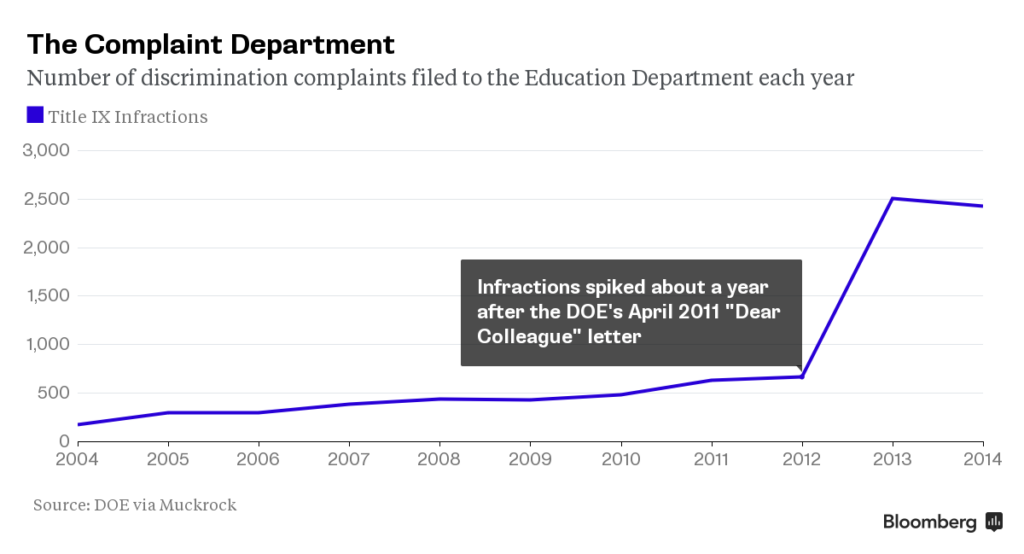
In a response to an inquiry by three U.S. Senators, the Office for Civil Rights (OCR) admitted that the average duration of a Title IX investigation was 1469 days in FY2014 and 940 days for FY2015. In 2009, it was 379 days, and the OCR’s stated goal – 180 days. The primary driver, in addition to some skewing from old cases, was the substantial increase in sexual violence complaints.
For colleges and universities, the burden of quadrupling Title IX allegations is further compounded by a myriad of factors specific to employee relations in higher education. From multiple groups of constituents guided by different grievance processes to a plethora of governing regulations and stakeholders, here are 3 factors that differentiate higher education employee relations.
Title IX: No person in the United States shall, on the basis of sex, be excluded from participation in, be denied the benefits of, or be subjected to discrimination under any education program or activity receiving Federal financial assistance.
1. Higher ed often segregates its own constituents in the Title IX grievance process
For federally funded education programs and activities, Title IX has broad coverage and protects students, faculty and staff. However, within institutions of higher education, the process of addressing allegations pertaining to Title IX is typically distinct for students on the one hand and faculty or staff on the other. It’s not necessarily surprising in that one group is employed by the institution, and the other is not. A quick perusal of just a few college or university websites shows that many have different Title IX coordinators for students and faculty or staff. On some campuses, Title IX allegations for students are handled by the Dean of Students or a Title IX Coordinator specific to the Office of Student Affairs. There is often a separate Title IX Coordinator for faculty and staff.
Consider the complications when an allegation is between members of different constituents, faculty member and student for example, and each group has a separate process. Even if there is no crossover, in many institutions there are different technology platforms for documenting allegations, one for managing student behavioral records and another broader system documenting faculty and staff allegations of misconduct. Documentation and management of critical Title IX data is, therefore, more cumbersome and often inconsistent across students, faculty and staff. Accessing it across constituencies can be another matter altogether, and because the data is on different platforms, it can be difficult to see the larger picture on campus.

2. Layers of regulations govern the reporting and response to sexual misconduct in higher ed
There are a vast array of laws and regulations which govern the reporting and response to sexual misconduct on campuses. As employees of the institution, some regulations are applicable to faculty and staff while other guidelines are applicable to students. In fact, the Higher Education Compliance Alliance has a formidable Compliance Matrix which is a compilation of the many regulations and laws dictating how colleges and universities respond to allegations of sexual harassment and assault.
To give just a few examples, there is the Campus Sex Crimes Prevention Act which requires sex offenders provide notice of enrollment in institutions of higher education. The Clery Act regulates the reporting of campus crimes, including sexual misconduct, and it has reporting guidelines to the student and employee population at large as well as to the Secretary of Education. In addition to Title IX, there is Title VII of the Civil Rights Act, which prohibits sexual harassment. The OCR also issues “Dear Colleague” letters meant to give guidance and provide clarification on the implementation and enforcement of Title IX, most recently in April of this year.
Another potential law set to impact higher ed, dubbed the Safe Campus Act, would prohibit a college or university from either initiating or carrying out a disciplinary proceeding for a sexual misconduct claim unless the alleged student victim has filed a formal complaint with police. If a law enforcement agency is investigating a claim, the institution can only carry out interim disciplinary sanctions.
For employees, the Americans with Disabilities Act (ADA) can also come into play. The ADA protects victims of domestic or dating violence, sexual assault or stalking. It specifically prohibits discrimination against a victim suffering from perceived or actual impairment due to sexual misconduct.
3. Higher ed has multiple stakeholders in the Title IX investigation process
In addition to multiple constituencies, there are many stakeholders once a Title IX related allegation is filed. These stakeholders have roles to play throughout the grievance process and require relevant case-specific updates. There is typically an informational hierarchy with some of the high level stakeholders given broad oversight of the process and access to all of the primary documentation while many other stakeholders will have only limited access to information. Logistically, it can be a challenging process to manage in the context of employee relations.
Beyond the victim and the accused, the stakeholders might include:
- Title IX Coordinator(s)
- Compliance
- Human resources
- Unions
- Office of Equity and Diversity
- Law Enforcement
- Administration
- U.S. Department of Education, Office for Civil Rights
- Advisor to Complainant
- Trained Title IX Investigator
- Adjudicator
- Appeals Panel
On a side note, a lengthy Title IX investigation process means there is always a risk of turnover amongst the key stakeholders. It’s yet another wrinkle for higher education employee relations.
Does the Complexity Really Matter?
The endgame is safer campuses.
If the multitude of regulations and reporting procedures, intricate and often segregated Title IX grievance processes, array of stakeholders, and multi-constituency nature of higher ed combine to create the proverbial Gordian knot, there are no winners. The average duration of a Title IX investigation might be the red flag.
Similar to the for-profit environment, thorough fact-finding and rigorous investigative procedures and documentation are fundamental to best practice employee relations. As the number of Title IX cases grow, rigor of process will be essential for higher education as well. I believe we will also see the emergence of more technology platforms that at one level, can provide an aggregate view of campus data for compliance, the Office of Equity and Diversity or human resources. At a different level, those same technology platforms will silo constituency data to protect the privacy of students, faculty and staff. And while technology will never reduce the vast number of laws and regulations, it can help institutions of higher education remain compliant and be cued to the many deadlines and reporting procedures that surround the Title IX grievance process.
It’s complicated, but when the average duration of a Title IX investigation is measured in months instead of years and the rising trend of sexual misconduct allegations on campuses truly reverses course, we’ll know we’re on the right track. Most importantly, our campuses will be safer.




